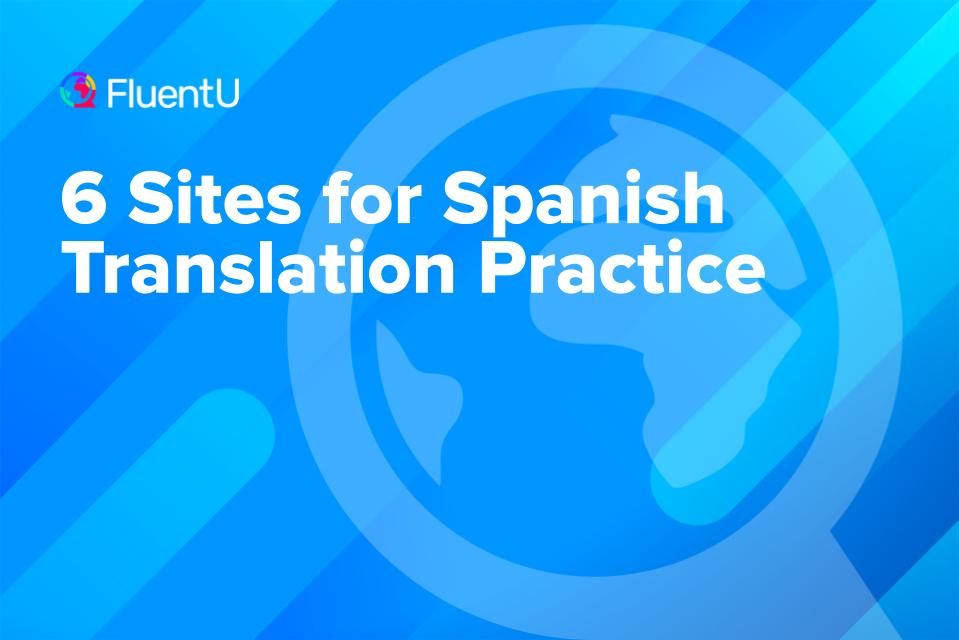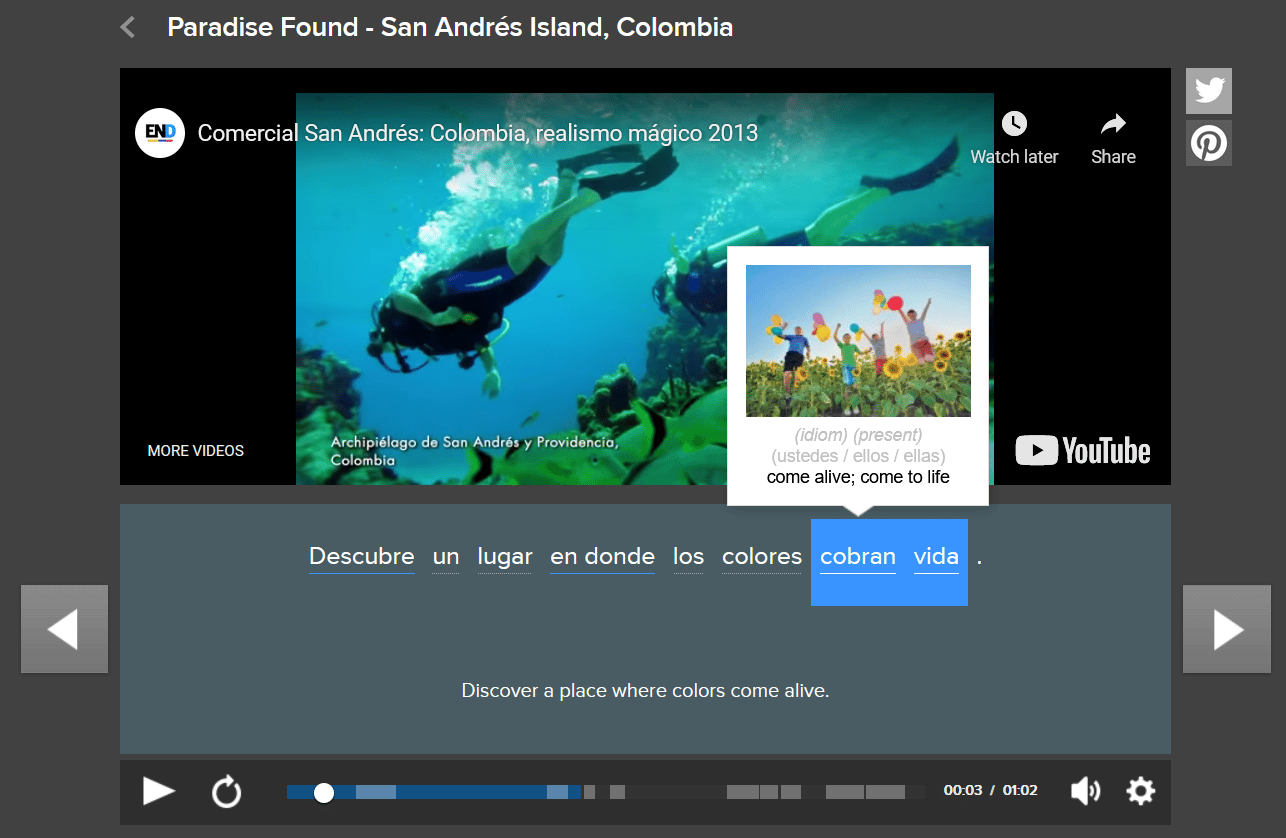Contents
6 Sites for Spanish Translation Practice

Just be glad you’re not a Spanish learner from 100 years ago.
Translation was the primary method of foreign language instruction in much of the Western world, and it wasn’t always fun.
But many linguists and educators still feel that translation is a vital part of foreign language learning. When done right, it can be extremely useful for vocabulary recall and grammar practice.
Luckily, thanks to the magic of the internet, there are plenty of resources available for Spanish translation practice!
In this post, you’ll find six Spanish translation exercises, from language learning platforms and captivating literature to explorations on Google Maps. We’ve also covered some of these resources in a video lesson on our YouTube channel:
Download: This blog post is available as a convenient and portable PDF that you can take anywhere. Click here to get a copy. (Download)
1. 123TeachMe
This Spanish language learning website offers an array of Spanish translation exercises covering multiple topics, from tenses and specific verbs to even a flan recipe!
On this website, the answers are hidden from the translation exercises. When you’re ready to check your answers, simply click on the button labeled “Translation” and you’ll be able to compare your translation to the one provided by 123TeachMe.
Before you start, make sure you have some paper or a document open on your device so you can write down your translations.
Here are a few translation activities you can start with:
Present – Estudiar, Aprender
Preterite Tense
Mix of Tenses 1
2. Authentic Spanish Videos on FluentU
The learning tools on this language learning program can work for getting in some Spanish translation practice—specifically, through videos. These videos are authentic, so they’re as close to real Spanish as possible. You can try translating from TV show and movie clips, news segments, inspirational talks, vlogs and other native content.
The bite-sized, authentic Spanish videos all come with interactive subtitles and full transcripts in both Spanish and English, which can be enabled simultaneously and appear as parallel text.
Following along with these as the video plays can give you a sense of the differences in each language’s phrasing and sentence structure. You can disable either the English or Spanish option at any time, and practice translating into one language or the other. Feeling stuck? You can also check the contextual meaning of any word while watching by hovering over it in the subtitles or by clicking on it if you’re on the iOS or Android app.
Videos are followed by custom quizzes, which often have opportunities to translate key moments from the video.
You can filter videos by topic, format or difficulty level, the latter of which includes two levels each for beginner, intermediate and advanced learners—each of which comes with a large selection of videos to choose from.
3. SpanishForNoobs.com
On SpanishForNoobs.com, not only can you access vocabulary lists, but there are also a ton of Spanish exercises covering Spanish tenses, articles, vocabulary, verbs, expressions and more.
Some of the exercises are fill-in-the-gap and multiple-choice activities. However, by selecting the option “Expressions and translations,” you’ll find exercises that ask you to translate full sentences from English into Spanish.
This is a useful resource with translation activities suitable for all Spanish learners, from beginners to advanced levels.
Here are some translation-based activities you could start with:
Various sentences (easy level)
Various sentences (intermediate level)
Various sentences (difficult level)
Exercise translation Spanish → English (easy level)
Exercise translation Spanish → English (difficult level)
4. Google Maps Directions
Driving directions can help beginner learners practice important vocabulary, as well as command conjugations for verbs. Luckily, Google Maps makes it easy to toggle between languages.
Click on the horizontal lines at the upper left-hand corner of the page and then select “Language” from the dropdown menu. There, select español (either European or Latin American—your preference). Then, search for directions to somewhere in your town or city.
The repetitive nature will help you learn vocabulary for directions (left, right, straight, turn, continue, etc.) quickly and efficiently. Get started with an area that’s familiar to you, then try exploring a Spanish-speaking country you’ve always wanted to visit!
5. AlbaLearning’s Textos Paralelos (Parallel Texts)
AlbaLearning offers an extensive collection of parallel texts, including short stories and poems. To find a good translation exercise, look for a text that features a Spanish flag as well as a US/UK flag—this indicates that it’s offered in both English and Spanish.
This website displays the Spanish text and the English text alongside each other. You just have to cover the English side while you’re doing your translation.
AlbaLearning’s parallel texts vary in length and difficulty level. For an intermediate speaker, I would recommend “The Princess and the Pea,” since it’s quite short and the story is familiar to most people.
A more advanced learner could try to tackle Cervantes’ “The Spanish-English Lady,” which is quite long but is broken into five manageable sections.
6. The Museo del Prado Website
Are you an art enthusiast? Why not try translating the educational and informative website of the Museo del Prado (The Prado Museum) in Madrid, Spain? Many individual pages on the website can be easily toggled between English and Spanish via the “ES/EN” button in the upper right-hand corner.
Plus, the website’s translations are generally pretty close to the original Spanish in terms of vocabulary and sentence structure.
Some examples are the various descriptions of the museum’s collections and information about current exhibitions. Even if you have no intention of visiting the Prado, you still might enjoy reading the Spanish version, translating a paragraph to English and then checking your translation. Since the vocabulary can be somewhat complicated and specific, this exercise is best for intermediate to advanced learners.
Pro tip: Lots of tourism-related websites are translated into multiple languages, so if you finish with the Prado website—or if art just isn’t your thing—you can also try this with other websites for museums, national parks, hotels or historic sites.
Why Translation Exercises Matter
I’ve had many Spanish teachers tell me that in order to learn Spanish, I should stop translating to English and focus on “thinking in Spanish.” This is good advice, for sure—but Spanish learners should also appreciate the importance of translation exercises, too.
When you sit down to translate a text from English to Spanish, you learn to pay attention to the way that native speakers write. How do they construct their sentences? What words do they choose and what colloquial expressions do they use? Do these phrases have English equivalents?
Asking yourself these questions can help you quickly improve your Spanish writing and comprehension. Plus, you’ll learn to think about Spanish sentence-by-sentence rather than word-by-word, which will make your own Spanish writing and speech sound more natural.
Translation exercises are also great for learning and reinforcing vocabulary. You know those words you see or hear all the time, but never quite remember the meanings of? Well, when you’re doing a close translation exercise, you’ll have no choice but to learn them.
And trust me, after looking them up in a dictionary a few times, you’ll never forget them.
How to Make Translation Exercises Fun
- Choose interesting material. By using authentic passages written by and for native speakers, you can practice Spanish and also learn about a topic that appeals to you. Spanish speakers of all levels, from absolute beginner to advanced, can find “real-world” texts to translate rather than relying on textbook exercises.
- Flag unfamiliar words and check them later. Another key to enjoying translation exercises is to avoid getting bogged down in unfamiliar vocabulary. Instead of consulting a dictionary every time you come across a word you don’t know, just jot it down and look for it later on. When I’m translating, I like to use a blank space, a star or a question mark to indicate a word I’m not sure about. Later, once I’ve translated the bulk of the paragraph, I come back and use context clues or a dictionary to fill in the gaps.
- Choose a text at the correct difficulty level. Choose a text that’s too easy and you won’t feel challenged. But a text that’s too difficult might leave you feeling overwhelmed.
How to “Grade” Your Own Translation Exercises
As with other aspects of language learning, it’s important to check your translations for accuracy. The revisions and corrections you make can be great learning resources.
It’s worth mentioning that there isn’t always just one way to translate something. Consider posting your translations on a language learning forum like the ones on WordReference or r/Spanish on Reddit, so a native speaker can read your work and weigh in.
Whether you’re a beginner or an advanced Spanish learner, it’s not hard to find online Spanish translation exercises.
Besides practicing your Spanish, you may even learn something interesting about art, food, culture or news in the process of translating.
Download: This blog post is available as a convenient and portable PDF that you can take anywhere. Click here to get a copy. (Download)








